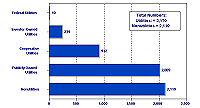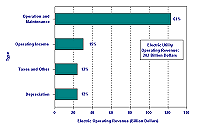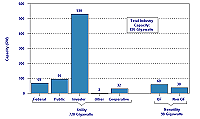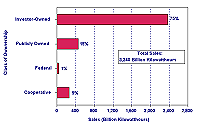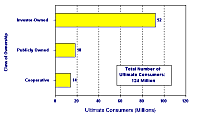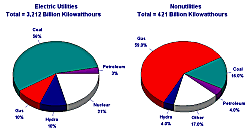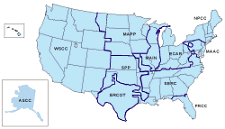Electric Power Industry Overview
|
Electricity is an integral part of life in the United States. It is indispensable to factories, commercial establishments, homes, and even most recreational facilities. Lack of electricity causes not only inconvenience, but also economic loss due to reduced industrial production. Various aspects of the electric power industry are provided in this overview.
The U.S. electric power industry is composed of traditional electric utilities, including power marketers, and nonutility power producers.
Consumer Sectors. Utility service territories
are geographically distinct from one another. Each territory is usually composed of many
different types of consumers. Electricity consumers are divided into classes of service or
sectors (residential, commercial, industrial, and other) based on the type of service they
receive. Sectorial classification of consumers is determined by each utility and is based on
various criteria such as:
Electric utilities use consumer classifications for planning (for example, load growth and peak demand) and for determining their sales and revenue requirements (costs of service) in order to derive their rates. Utilities typically employ a number of rate schedules for a single sector. The alternative rate schedules reflect consumers' varying consumption levels and patterns and the associated impact on the utility's costs of providing electrical service. Reclassification of consumers, usually between the commercial and industrial sectors, may occur from year to year due to changes in demand level, economic factors, or other factors.
Revenue. The revenue associated with sales to ultimate consumers is the operating revenue reported by the utility. Operating revenue includes energy charges, demand charges, consumer service charges, environmental surcharges, fuel adjustments, and other miscellaneous charges. Among other costs of service, utility operating revenues include State and local taxes, Federal income taxes, and other taxes paid by the utility. State and local authorities tax the value of plants (property taxes), the amount of revenues (gross receipts taxes), purchases of materials and services (sales and use taxes), and a potentially long list of other items that vary extensively by taxing authority. Federal taxes are for the most part "payroll" taxes. Taxes deducted from employees' pay, such as Federal income taxes and employees' share of Social Security taxes are not a part of the utility's "tax costs," but are paid to the taxing authorities in the name of the employees. These taxes are included in the electric utility's costs of service (for example, revenue requirements) and are included in the amounts recovered from consumers in rates and reported in operating revenues. Electric utilities, like other business enterprises, are required by various taxing authorities to collect and remit taxes assessed on their consumers. In this regard, the utility serves as an agent for the taxing authority. Taxes assessed on consumers, such as sales taxes, are called "pass through" taxes. These taxes do not represent a cost to the utility and are not recorded in the operating revenues of the utility. However, taxing authorities differ on whether a specific tax is assessed to the utility or to the consumer, a difference that in turn determines whether or not the tax is included in the electric utility's operating revenues.
Average Revenue per Kilowatthour (Price). Average revenue per kilowatthour is defined as the cost per unit of electricity sold (a reasonable proxy for price) and is calculated by dividing retail electric revenue by the corresponding sales of electricity. The average revenue per kilowatthour is calculated for all consumers and for each sector (residential, commercial, industrial, and other). The average revenue per kilowatthour discussed in this primer represents a weighted average of consumer revenue and sales within each sector and across sectors for all consumers. Average revenue per kilowatthour is affected by changes in the rate schedules used by the electric utilities and by changes in the volume of electricity sales. Because fixed charges remain constant regardless of the volume of sales, average revenue per kilowatthour decreases as the volume of sales increases. A change in average revenue per kilowatthour may occur when the volume of electricity sales changes (because of an increase/decrease in the use of electricity by individual consumers or an increase/decrease in the number of ultimate consumers) across all sectors or within a specific sector. Generally, the rate schedules used by electric utilities are designed so that as the volume of sales increases, the revenue increases at a slower rate, lowering the average revenue per kilowatthour. Average revenue per kilowatthour is also affected by class of utility ownership and by class of service (sector). Classes of Ownership. The electric utility industry in the United States includes 3,170 investor-owned, publicly owned, cooperative, and Federal electric utilities. Historically, investor-owned electric utilities have been most successful in serving large, consolidated markets where economies of scale afford the lowest prices. However, publicly owned, cooperative, and Federal electric utilities all have a role in producing, transmitting, and distributing electricity.
Investor-owned electric utilities are privately owned entities. They represent 8 percent of the total number of electric utilities and approximately 75 percent of electric utility generating capability, generation, sales, and revenue in the United States. Like all private businesses, investor-owned electric utilities have the fundamental objective of producing a return for their investors. These utilities either distribute profits to stockholders as dividends or reinvest the profits. Investor-owned electric utilities are granted service monopolies in certain geographic areas and are obliged to serve all consumers. As franchised monopolies, these utilities are regulated and required to charge reasonable prices, to charge comparable prices to similar classifications of consumers, and to give consumers access to services under similar conditions. Most investor-owned electric utilities are operating companies that provide basic services for the generation, transmission, and distribution of electricity. The majority of investor-owned utilities perform all three functions. They operate in all States except Nebraska, where electric utilities consist primarily of municipal systems and public power districts.
Publicly owned electric utilities are
nonprofit local government agencies established to provide service to their communities and
nearby consumers at cost, returning excess funds to consumers in the form of community
contributions, increased economies and efficiencies in operations, and reduced rates.
Publicly owned electric utilities include:
Most municipal electric utilities simply distribute power, although some large ones produce and transmit electricity as well. There are 2,009 publicly owned electric utilities in the United States. They represent about 63 percent of the number of electric utilities, supply approximately 10 percent of generation and generating capability, and account for about 15 percent of retail sales and 14 percent of revenue. They obtain their financing from municipal treasuries and from revenue bonds secured by proceeds from the sale of electricity. Public power districts and projects are concentrated in Nebraska, Washington, Oregon, Arizona, and California. Voters in a public utility district elect commissioners or directors to govern the district independent of any municipal government. State authorities, like the Power Authority of the State of New York or the South Carolina Public Service Authority, are agencies of their respective State governments. Irrigation districts may have other forms of organization. In the Salt River Project in Arizona, for example, votes for the board of directors are apportioned according to the size of landholdings. Cooperative electric utilities are owned by their members and established to provide electricity to those members. These electric utilities operate in rural areas with low concentrations of consumers because these areas historically have been viewed as uneconomical operations for investor-owned utilities. There are 882 cooperatives operating in 47 States; none operate in Connecticut, Massachusetts, Rhode Island, or the District of Columbia. Cooperative electric utilities represent about 27 percent of U.S. electric utilities, 10 percent of sales and revenue, and around 4 percent of generation and generating capability. Cooperatives are incorporated under State laws and are usually directed by an elected board of directors, which in turn selects a manager. The Rural Utilities Service (formerly the Rural Electrification Administration), the National Rural Utilities Cooperative Finance Corporation, the Federal Financing Bank, and the CoBank ACB are important sources of debt financing for cooperatives.
The 10 Federal electric utilities in
the United States are part of several agencies in the U.S. Government:
Three Federal agencies operate generating facilities:
The TVA markets its own power while generation by the U.S. Army Corps of Engineers (except for the North Central Division, for example, Saint Mary's Falls at Sault Ste. Marie, Michigan) and the U.S. Bureau of Reclamation is marketed by the Federal power marketing administrations: Bonneville, Southeastern, Southwestern, and Western Area. The four power marketing administrations also purchase energy for resale from other electric utilities in the United States and Canada. Alaska, the fifth power marketing administration, owned and operated two hydropower facilities (Eklutna and Snettisham). On November 28, 1995, President Clinton signed a bill authorizing the sale of these projects. Final transfer of title to the State of Alaska and three Alaskan utilities occurred August 1998 after which the Alaska Power Administration ceased to exist. Federal electric utilities represent less than 1 percent of all electric utilities, provide approximately 10 percent of all generating capability and generation, and account for about 1 percent of total sales to ultimate consumers and less than 1 percent of the associated revenue. Federal electric utility generation is primarily sold for resale to municipal and cooperative electric utilities and to other nonprofit preference consumers, as required by law. Federal power is sold not for profit, but to recover the costs of operations. Federal electric utilities operate approximately 180 power plants. Most of the power plants are Federal hydroelectric projects initially designed for flood control and irrigation purposes.
Qualifying Facilities. PURPA facilitated the emergence of a group of nonutility electricity-generating companies called qualifying facilities or QFs. Under PURPA, small power producers and cogenerators receive status as a QF by meeting certain requirements for ownership, operating methods, and efficiency. Those requirements were established by the Federal Energy Regulatory Commission (FERC). Cogenerators. Facilities which produce electricity and another form of useful thermal energy through the sequential use of energy (usually heat or steam for industrial processes or heating/cooling purposes) are called cogenerators--many of which have status as QFs. Cogenerators are primarily engaged in business activities (such as, agriculture, mining, manufacturing, transportation, education). The electricity that they do generate is mainly for their own use, but any excess is sold to the host utility. Independent Power Producers. These facilities (known as IPPs) must use renewable energy as a primary source for generation of electricity. IPPs operate within the franchised territories of host utilities. They do not possess transmission facilities or sell electricity on the retail market (that is, all their sales are wholesale or sales for resale). By definition, a facility that has QF status is not an IPP. Exempt Wholesale Generators. EPACT modified the Public Utility Holding Company Act (PUHCA) and created another class of nonutility power producers: exempt wholesale generators (EWGs). EPACT exempted EWGs from the corporate and geographic restrictions imposed by PUCHA. With this modification, public utility holding companies are allowed to develop and operate independent power projects anywhere in the world.
Various sources of energy can be converted into electric energy or electricity. The major or dominant sources include fossil fuels, uranium, and water.
Fossil fuels supply about 70 percent of the energy sources for the generation requirements of the Nation. Coal, petroleum, and gas are currently the dominant fossil fuels used by the industry. Other sources of energy can also be converted into electricity, including:
When fossil fuels are burned to generate electricity, a variety of gases and particulates are formed. If these gases and particulates are not captured by some pollution control equipment, they are released into the atmosphere. This overview provides a brief summary of the gaseous emissions from U.S. electric utilities and the methods employed to reduce or eliminate their release into the atmosphere. Among the gases emitted during the burning of fossil fuels are sulfur dioxide (SO2), nitrogen oxides (NOx), and carbon dioxide (CO2). Power Transactions An electric power system is a group of generation, transmission, distribution, communication, and other facilities that are physically connected and operated as a single unit under one control. The flow of electricity with the system is maintained and controlled by dispatch centers. It is the responsibility of the dispatch center to match the supply of electricity with the demand for it. In order to carry out its responsibilities, the dispatch center is authorized to buy and sell electricity based on system requirements. Authority for those transactions has been preapproved under interconnection agreements signed by all the electric utilities physically interconnected or with coordination agreements among utilities that are not connected. The Interconnected Networks
The U.S. bulk power system has evolved into three major networks (power
grids), which also include smaller groupings or power pools. The major networks consist of
extra-high-voltage connections between individual utilities designed to permit the transfer
of electrical energy from one part of the network to another. These transfers are restricted,
on occasion, because of a lack of contractual arrangements or because of inadequate
transmission capability. The three networks are:
The Texas Interconnected System is not interconnected with the other two networks (except by certain direct current lines). The other two networks have limited interconnections to each other. Both the Western and the Texas Interconnect are linked with different parts of Mexico. The Eastern and Western Interconnects are completely integrated with most of Canada or have links to the Quebec Province power grid. Virtually all U.S. utilities are interconnected with at least one other utility by these three major grids. The exceptions are in Alaska and Hawaii. The interconnected utilities within each power grid coordinate operations and buy and sell power among themselves. The bulk power system makes it possible for utilities to engage in wholesale (for resale) electric power trade. Wholesale trade has historically played an important role, allowing utilities to reduce power costs, increase power supply options, and improve reliability. Historically, almost all wholesale trade was within the National Electric Reliability Council (NERC) regions, but utilities are expanding wholesale trade beyond those traditional boundaries. U.S. international trade is mostly imports. Normally, most imports are from Canada and the remainder are from Mexico.
Overall reliability planning and coordination of the interconnected power systems are the responsibility of NERC, which was voluntarily formed in 1968 by the electric utility industry as a result of the 1965 power failure in the Northeast. NERC's nine regional councils cover the 48 contiguous States, part of Alaska, and portions of Canada and Mexico. The councils are responsible for overall coordination of bulk power policies that affect the reliability and adequacy of service in their areas. They also regularly exchange operating and planning information among their member utilities. The boundaries of the NERC regions follow the service areas of the electric utilities in the region, many of which do not follow State boundaries. At present, the industry is in transition. Steady progress toward competitive wholesale markets for electric power recently has been accelerated by FERC Order 888, which opens access to transmission lines and encourages greater wholesale trade.
The electric power industry is evolving from a highly regulated, monopolistic industry with traditionally structured electric utilities to a less regulated, competitive industry. PURPA opened up competition in the generation market with the creation of qualifying facilities. EPACT removed some constraints on ownership of electric generation facilities and encouraged increased competition in the wholesale electric power business. The EPACT amended the Federal Power Act (FPA) such that any electric utility can apply to the FERC for an order requiring another electric utility to provide transmission services (wheeling). Prior to EPACT, the FERC could not mandate that an electric utility provide wheeling services for wholesale electric trade. This change in the law permits owners of electric generating equipment to sell wholesale power (sales for resale) to noncontiguous utilities. In April 1996, the FERC issued two final rules, 888 and 889, implementing EPACT's provisions for open access to transmission lines. Rule 888 addresses equal access to the transmission grid for all wholesale buyers and sellers, transmission pricing, and the recovery of stranded costs. Stranded costs are investments, mostly in generation, made by utilities under the regulated environment that are presently recovered in cost-based rate structures and may not be recoverable in a competitive environment with market-based rates. Rule 889 requires jurisdictional utilities that own or operate transmission facilities to establish electronic systems to post information about their available transmission capacities. In response to these rulemakings, utilities are proposing to form Independent System Operators (ISOs) to operate the transmission grid, regional transmission groups, and open access same-time information systems (OASIS) to inform competitors of available capacity on their lines. The provision for open transmission access in EPACT has also facilitated the creation of new participants in the electric power industry, power marketers and power brokers. Power marketers are entities engaged in buying and selling wholesale electricity and fall under the jurisdiction of the FERC, since they take ownership of electricity and are engaged in interstate trade. Power brokers, who do not take ownership of electricity, are not regulated by the FERC. A growing number of power marketers have filed with the FERC and had rates approved. Power marketers generally do not own generation or transmission facilities or sell power to retail customers. However, continuing deregulation of the industry is allowing power marketers the possibility of entering retail electricity markets. Many State legislatures and the Congress are considering legislation that will allow competition in retail sales of electric power. In 1996, Rhode Island and California passed bills that will allow end-use customers in their States to choose among competitive generation suppliers. The plans allowed retail choice for some consumers as early as 1997, and will phase in retail choice for all consumers by 2001. Transmission and distribution will remain regulated functions with rules to assure open access to lines for all competitors. Pilot programs for retail wheeling are underway in New Hampshire and at major utilities in several States. This interest in retail competition points to an increasingly competitive electric power industry. Presently, electric rates are based on embedded historical costs. Future electric rates are likely to be dynamic, reflecting the current cost of providing service. In a competitive environment, unbundling of electric power services and pricing that reflects time-of-day and seasonal variations may become more common. Continuing deregulation at both Federal and State levels is transforming the historically monopolistic electric power industry into a competitive industry that will eventually increase competition in its generation and service components, and change the nature of the way electricity is priced, traded, and marketed in the United States. Endnote: 1The Energy Information Administration publications,
used as input to this overview are accessible on the Internet at the following web site
addresses:
Contact: |
|
| Topics
 Generating Capability/Capacity: various
methods for converting energy into electricity. Generating Capability/Capacity: various
methods for converting energy into electricity.
Electric Utilities Nonutility Power Producers  Electricity Generation: energy sources
used to generate electricity. Electricity Generation: energy sources
used to generate electricity.
Generation from Fossil Fuels Nuclear-Powered Generation Generation from Renewable Fuels  Fossil Fuel/Consumption, Stocks, and
Receipts. Fossil Fuel/Consumption, Stocks, and
Receipts.
Nonutility Facilities Electric Utilities Consumption and Stocks Receipts and Costs Coal Petroleum Gas  Sales, Revenue, and Price: describes
electric utility companies, their service territories, enduse sectors, revenue
requirements, and average revenue per kilowatthour of electricity sold (a proxy for
price). Sales, Revenue, and Price: describes
electric utility companies, their service territories, enduse sectors, revenue
requirements, and average revenue per kilowatthour of electricity sold (a proxy for
price).
 Environmental Aspects: a discussion on
the gaseous emissions from U.S. electric utilities and the methods employed to reduce or
eliminate their release into the atmosphere. Environmental Aspects: a discussion on
the gaseous emissions from U.S. electric utilities and the methods employed to reduce or
eliminate their release into the atmosphere. Electric Power Transactions & The Interconnected
Networks: a discussion on the major networks (power
grids) that have evolved in the United States and the
wholesale trade of electric power. Electric Power Transactions & The Interconnected
Networks: a discussion on the major networks (power
grids) that have evolved in the United States and the
wholesale trade of electric power.
|
